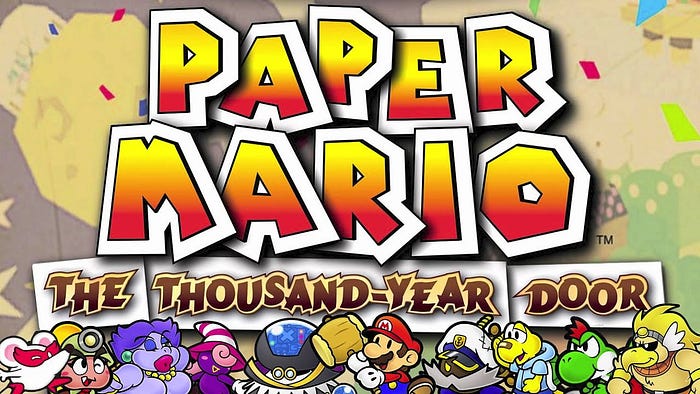Paper Mario: The Thousand-Year Door Review

Reviews: Paper Mario | Super Paper Mario | Paper Mario: SS | Paper Mario: CS | Paper Mario: OK
I’ve always considered Paper Mario: The Thousand-Year Door as my favorite video game of all time. The developers at Intelligent Systems crafted a game that seems tailored for me because of its success in executing and blending all of my favorite video game genres: puzzle, strategy, and RPG. The result is this 2004 video game that seems as though it was bound to be my favorite. While that claim may come without any legitimate justification other than personal bias, I still find TTYD to be one of the finest video games of all time, especially of the RPG genre. The game oozes endless personality and unyielding charm that to this day, I continue to hold it very close to my heart.
First and foremost, TTYD does everything a great sequel should do: it sticks with the same structure and concepts from the original and cranks them up to an 11. Nintendo actually took advantage of the theming this time around and applied paper-based visual effects into both the gameplay and general aesthetic. They also cranked up the battle system mechanics and gave partners the agency they deserve by letting them dodge attacks, bestowing them with HP, and even letting a few badges apply to them rather than just Mario alone.
Along with the gameplay, the adventure is cranked up as well. Chapters are longer, grander, and contain more intricate dungeons, yet that doesn’t make them feel cumbersome. Sure, there’s some backtracking here and there, but it never detracts from the experience because every chapter is special and clearly had tons of thought and care put into them.
For example, my favorite three chapters: chapter 2, chapter 3, and chapter 6. In C2 (The Great Boggly Tree), puzzles are primarily solved with the help of 101 little creatures that follow you called Punies, almost like a less complicated Pikmin situation. C3 (The Glitz Pit) completely diverts from puzzle-solving and has Mario and co. enter a fighting league and work their way up to the top while also uncovering a conspiracy within the league. And C6 (The Excess Express) has Mario playing detective by solving minor whodunit mysteries for three days on a luxurious train, which turns out to be a nice brief break from slaying enemies.
All of these chapters (to me at least) show that Intelligent Systems isn’t concerned with conventional gameplay. In a sense, they are, but most of the adventuring is super uncharacteristic of any “mainstream” RPG. There are even multiple points where characters break the fourth wall, which is the only game I know of (realize I’m really stressing this) that does this. There’s a point in chapter 4 where you have to guess a villain’s name in order to beat him, but in order to do so, Mario must find the letter “p” because the villain somehow swiped it from the in-game keyboard. As far as I’m concerned, I consider that an instance in which Intelligent Systems stretched the boundaries of the video game medium.
TTYD very much has an attractive open world vibe. Wanting to complete this game as fast as possible, I failed to suppress my urge and just had to complete a few side quests and grind for a few of the game’s secrets. The hub world (and sub-hub world) is expansive, irresistible, and most of all, full of life. Everything is free to explore and waiting to be uncovered. Unreachable secrets and areas encourage the player to continue their main quest, and revisiting past areas is put to worth as well by including unattainable treasures (until you unlock the ability later) and a favor system that allows you to complete random tasks and earn rewards from NPCs you’ve helped before.
It’s no surprise that with all these new flamboyant touches the battle system is shown some love. There is now a crowd spectating the battle that will award you star points depending on how well you’re hitting the action commands and a roulette wheel that’ll either save your life or screw you over big time. The badges are plentiful and more varietal, too, and make the strategy and preparation a lot more complex. And much like the first installment, enemies are frequent enough for the player to level up at a smooth pace.
And, of course, what a game it wouldn’t be without the story. I rarely find these aspects commendable, but this game is an exception. Every character is unique and has their own backstory, the memorable NPCs are all aided with goofy, expressive dialogue, and the plot screams epic in every sense of the word. You’ve got dragons, a robot that falls in love, a ghost who turns residents into pigs, and a power-hungry villain who yearns to wake an ancient demon. This game has it all. Paper Mario: The Thousand-Year Door is sincerely one-of-a-kind.
10/10








